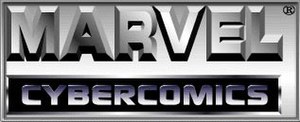History
CyberComics were created by Marvel in the summer of 1996 as a part of a promotional deal with America Online. The CyberComics were placed into the AOL/Marvel Zone and were exclusively available to AOL users.
From 1996 till 1998 there was a run of the Spider-Man Cybercomics.
In 1997 Marvel built their own website at MarvelOnline.com and the CyberComics were freely available to all users through registration on MarvelZone.com (due to the contract with AOL).
On September 17, 1999 NextPlanetOver.com (NPO), a now-defunct online comics store, announced a one-year marketing and content licensing deal with Marvel Comics. Terms included a year of run-of-site advertising on Marvel.com. In addition, NextPlanetOver.com was sponsoring monthly CyberComics created exclusively for them by Marvel. NPO was bought out less than a year later and went bankrupt in 2000; the CyberComics were renamed into "Webisodes" and made available at Marvel.com for free without any registration.
The first characters to star in CyberComics were Spider-Man and Wolverine, soon followed by several others. The comics were not only canon to the mainstream but also tied in directly with Marvel's newsstand offerings. They came out on a monthly basis, in four parts consisting of eight pages each.
Using Macromedia's Shockwave software, readers guided the action by clicking through word balloons and following panels complete with animation, sound effects and music. CyberComics were still very much in the comic book or strip genre - the result was a cross between comics and animation.
The Cybercomics were made by taking penciled pages and transforming them through a program called "Electric Image Painter" and form-Z into the digital comics, colored in digitally in Adobe Illustrator. Simple animations were created in Macromedia Shockwave, and Garry Schafer of grimmwerks created the soundscapes which drove the animations. Done at a time previous to mp3 compression as common as it is now, only 4 channels of small, short soundscapes could be used at one time.
Due to financial reasons, the production of new CyberComics ceased in 2000 and Marvel removed them from their website.
Having a huge back-issue archive, Marvel decided to save money by replacing Marvel CyberComics with Dotcomics. This successor would eventually become Marvel Unlimited.
Marvel's Excelsior Theatre
Scoop:
The only "movie" in this "theatre" was called The Secret Adventures of Captain America - Far Flung in the Far East and came out in five parts in 1999-2000. It was conceived by former editor and Stan-hattan Project founder James Felder and co-written by James Felder, Ben Raab and Joe Kelly with art/designs by John Cassaday and overseen by John Cerilli; sound effects, music, animation and even the voice of Captain America was provided by Garry Schafer. The idea was to do a Flash animated series with actors and writers contributing the characters' voices - all involved recorded parts - John Cerilli was Nick Fury, for example. Sort of a retro-modern version of the old movie serials with a bit of the Orson Welles's Mercury Theatre radio show vibe. It was discontinued after the fifth episode without bringing the story to an end for unclear reasons.
Story:
Chasing down a mysterious phenomenon in East Asia during the WWII, Cap confronts the nefarious Mandarin! A certain Sergeant Fury is present and accounted for as well, but with allies like these...
Other appearances include Dum Dum Dugan and Sgt. Fury's Howling Commandos, consisting of Dino Manelli, Rebel Ralston, Gabe Jones, Pinky Pinkerton and Izzy Cohen.
- Episode 1: Valley of Death
- Episode 2: In the Clutches of the Mandarin
- Episode 3: The Valley of Lost Spirits
- Episode 4: The Road of Frozen Hells
- Episode 5: Fireworks
Review:
The adventure featured numerous "firsts", including a new first meeting of Captain America and Nick Fury; one that is decidedly different than the one featured in the pages of Sgt Fury comic. Much more advanced than the CyberComics, it had music and actors performing their parts and more advanced animation. Oddly the story seemed to take the stand that Nick Fury was somehow opposed to Captain America beforehand, seeing him as some kind of glorified piece of propaganda.
This page is based on this
Wikipedia article Text is available under the
CC BY-SA 4.0 license; additional terms may apply.
Images, videos and audio are available under their respective licenses.
